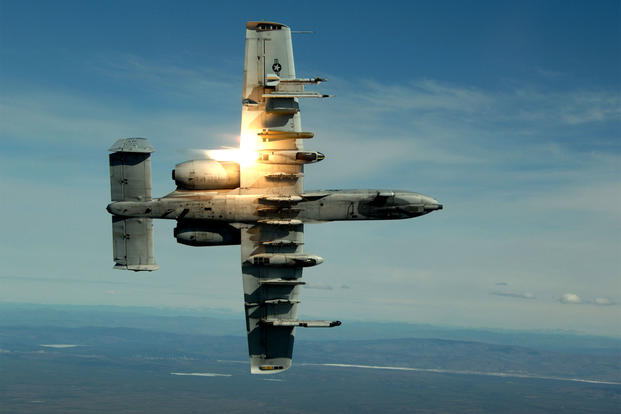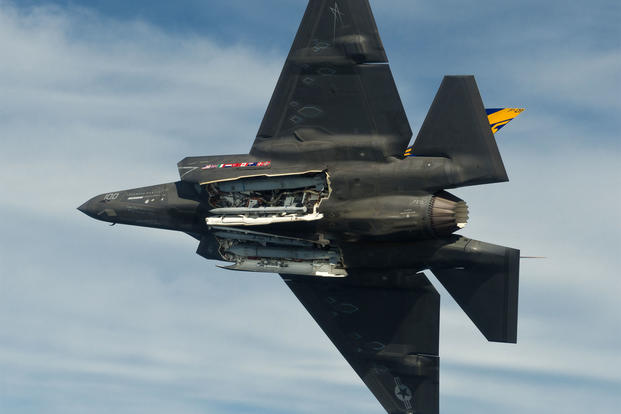RAF FAIRFORD, England -- While the congressionally mandated close-air support tests between the F-35 Joint Strike Fighter and A-10 Warthog wrapped up this week, lawmakers may not be satisfied with the results as questions continue to swirl about how each performed.
"I personally wrote the specific provisions in the [Fiscal 2017 National Defense Authorization Act] mandating a fly-off between the F-35 & A-10," Rep. Martha McSally, an Arizona Republican, tweeted Friday. "It must be carried out per Congressional intent & direction."
McSally, a former A-10 pilot whose home state includes Davis-Monthan Air Force Base, said she had reached out to Air Force Chief of Staff Gen. David Goldfein to "ensure an objective comparison."
The requirement that the two aircraft go up against each other was included as a provision in the bill amid congressional concerns over plans to retire the A-10 and replace it with the F-35. McSally was one of the architects of the bill's language.
Related content:
- Why Trump Is Sending a Key Deal-Maker to Farnborough Airshow
- Military.com Farnborough Airshow Coverage
- Air Force Backing Off Its Plan to Keep A-10s in the Air Through 2030
Her comments follow a Project on Government Oversight report that slams what it calls skewed testing techniques, saying the flights overwhelmingly favored the F-35.
The watchdog organization, which obtained the Air Force's test schedule and spoke to unidentified sources relevant to the event, claimed that the limited flights also curbed the A-10's strengths while downplaying the F-35's troubled past and current program stumbles.
The Defense Department says it is complying with the required testing.
The JSF operational test team and other Initial Operational Test and Evaluation officials "faithfully executed" the F-35 vs. A-10 comparison test "in accordance with the IOT&E test design approved in 2016," and did so in compliance with 2017 NDAA requirements, said Army Lt. Col. Michelle L. Baldanza, spokeswoman for the Office of the Director, Operational Test and Evaluation (DOT&E).
The testing happened from July 5 to 12 at Edwards Air Force Base, California, Baldanza said in an email.
"The [Joint Operational Test Team] will continue to schedule and fly the remaining comparison test design missions when additional A-10s become available," she said.
She said the data points collected will add to the scope of the side-by-side comparison test.
The "matched-pair" fourth-generation A-10 and fifth-generation F-35A comparison test close-air support missions "are realistic scenarios involving a Joint Terminal Attack Controller (JTAC), surface-to-air threats, some live and inert air-to-ground weapons employment, and varying target types," which include "moving target vehicles and armored vehicles across different conditions," such as day and night operations and low-to-medium threat levels, Baldanza said.
"The challenging scenarios are designed to reveal the strengths and limitations of each aircraft," she said, referring to radars, sensors, infrared signatures, fuel levels, loiter time, weapons capability, electronic warfare and datalinks.
"Each test design scenario is repeated by both aircraft types while allowing them to employ per their best/preferred tactics and actual/simulated weapons loads," Baldanza said. "Therefore, references to individual scenarios or specific weapons loadouts will not reflect the full scope of the comparison test evaluation."
DOT&E will analyze the flight test data collected and results will be compiled in an IOT&E report as well as DOT&E's "Beyond Low-Rate Initial Production" report.
The reports will offer comparative analyses of "differences, strengths, and weaknesses of the F-35A versus the A-10 across the prescribed comparison test mission types [and/or] scenarios," the DoD said.
For these reasons, the Air Force has consistently avoided calling the highly anticipated test a "fly-off." Aviation enthusiasts and pilots have also said putting the two aircraft side-by-side remains an apples-to-oranges comparison.
In addition to a variety of rockets, missiles and bombs fastened to hardpoints under its wings, the A-10 most notably employs its GAU-8/A 30mm gun system, which produces an iconic sound that ground troops never forget.
"There's just nothing that matches the devastation that that gun can bring," A-10 pilot "Geronimo" said in the 2014 mini-documentary "Grunts in the Sky: The A-10 in Afghanistan." The nearly four-year-old footage was made public in January.
"The ground troops that I work with -- when they think close-air support, they think A-10s," Staff Sgt. Joseph Hauser, a Joint Terminal Attack Controller then based at Forward Operating Base Ghazni in Afghanistan, said in the footage.
But the F-35, a stealth platform with high-detection sensors that is expected to have a wide variety of munitions once its delivery capacity software is fully implemented, is meant to penetrate a contested airspace using its very-low-observable abilities.
Those qualities are what will get the fighter through the door before it performs a CAS-type role, officials say.
"In a contested CAS scenario, a JTAC would absolutely want to call this airplane in, and we practice just that," said Capt. Dojo Olson, the Air Force's F-35A Heritage Flight Team commander and a pilot with the 56th Fighter Wing at Luke Air Force Base, Arizona.
Olson spoke with Military.com during the Royal International Air Tattoo airshow here at RAF Fairford, England.
"We practice close-air support, and we practice contested close-air support, or providing close-air support in a battlespace that is not just totally permissive to fourth-generation airplanes," he said.
"We foresee future combat environments where even in close-air support, even in counterinsurgency operations, there will be air defense systems," added Steve Over, F-35 international business development director. "And you need to have sensors that will be able to find the target."
The service has also expanded how it defines close-air support. For example, bombers such as the B-52 Stratofortress and B-1B Lancer can execute CAS missions -- but only by using precision-guided weapons.
"It may not do it the exact same way as legacy systems do," Over said. "The most prominent legacy close-air support platform that's currently in use is the A-10, and it uses a large Gatling gun on the nose of the aircraft."
He added that the F-35A model also has a Gatling gun -- the GAU-22/A four-barrel 25mm gun, made by General Dynamics. "But more than likely it's going to be using other precision-guided munitions" such as small-diameter or laser-guided bombs, he said.
Olson agreed.
"You can provide [CAS] from a precision-strike platform from tens of thousands of feet in the air, so there's a lot of different types of" the mission, he said. "Getting up close and personal like an A-10? Of course, the airplanes … they're apples and oranges."
-- Oriana Pawlyk can be reached at oriana.pawlyk@military.com. Follow her on Twitter at @Oriana0214.













